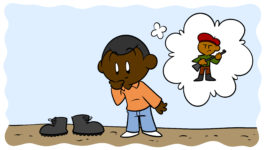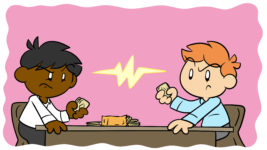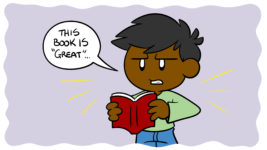Ah, the humble paragraph. If not the most basic tool in the writer’s toolbox, then certainly in the top five. Of course, like any basic tool, we take it for granted, to the point where many writers don’t know how much they can get from managing their paragraphs or, worse, are making basic mistakes that hurt otherwise excellent stories.
That’s why, in this article, I’ll be looking at five ways your paragraphs can be broken that you might not even notice, and the simple steps you can take to make sure they’re working in tandem with your writing. Of course, to do that, I’ve got to answer a pretty major question.
Are paragraphs really that important?
A few months ago, my laptop blew up. When I took it to be fixed, the guy behind the counter asked after the four tiny, rubber footpads that had been on the bottom when I bought it. I told him that they’d gradually fallen off over a year ago – two were in my wallet to stick back on ‘later’, one was on some shelf or other, and the last was lost in the fibers of a long-forgotten carpet.
“There’s your problem, then,” he said.
Turns out that rather than being for some nebulous ‘gripping’ purpose, those useless discs of rubber were meant to elevate the laptop just enough that the fan could do its job. Without them, the fan had slowly broken down, letting the laptop overheat until BOOM! (and it was a ‘BOOM!’)
This is the role paragraphs play in written work. They don’t look like they’re doing much, they don’t demand constant attention or upkeep, and you can even misuse them for a long time without ill-effect, but if you let them go wrong, you will pay the price down the line. If that price is anything like a new fan plus labor, you’re going to be as irritated with yourself as I was.
Mess up your paragraphs and it’ll come back to bite you.Click To TweetSo how can poor paragraphs spoil a story? Well, for a start, they’re part of a pacing structure that goes ‘words → sentence → paragraph → chapter → section/act → book → series’. Get one link in that chain wrong, and the error transfers to the next category, and the next, until your chapters are too long, your acts are uneven, and your book is just lopsided enough to lose a reader’s attention.
On a more immediate level, paragraphs are designed to make the process of reading easier. Poor paragraphs show readers that they’ve got a slog ahead, making reading less pleasurable, and act as a warning sign that other aspects of the story might offer a similarly bumpy ride.
So that’s why you should take the time to make sure your paragraphs are in good shape, but what does a ‘bad’ paragraph look like, anyway?
1. Inconsistent paragraph breaks
I’ll talk soon about the things that a paragraph break tells the reader, but before that, there’s something a little more basic to consider. This is the fact that, for paragraphs to mean anything to the reader – for them to pass on the information they’re designed to impart – they have to be treated consistently.
Many authors only consider their paragraphs in moments of particular drama or tension. Suddenly faced with making conscious decisions about their text, they tend to introduce a paragraph at any and every given opportunity, so that the text becomes choppy and staccato – more a series of moments than a cohesive narrative.
That might be an effect you want, but it’s something you should only be doing consciously. It can be incredibly helpful for authors to imagine paragraph breaks as changes in camera angle. Of course, there are lots of successful films where the camera angle changes constantly, and lots where it hardly changes at all, but imagine a film where, for most of the time, the camera angle changes seemingly at random, except for important points in the plot where it’s suddenly flashing around everywhere.
It’s a tacky effect, and the same is true in writing. Yes, in skillful hands it can be redeemed, but what makes those hands skillful is that they know what they’re doing with all their paragraphs. So do you have to put every paragraph break under the microscope to judge if it has a place in your story? Maybe when you’re editing, but no, not really: what you need is to have some personal rules for when you break a paragraph.
I say ‘personal’ because paragraph length is, like sentence structure and vocabulary, down to the author. Some people love longer passages while others will only write short parcels of text before moving on. The extremes are an issue, but otherwise you should be considering these rules in terms of what works for your story. Again, the important thing is that you’re making informed choices. That said, there are some hard-and-fast rules.
2. Undivided dialogue
This one’s nice and easy – new dialogue starts on a new line.
“Does it?” I asked.
“Yes, it does,” I answered.
Having different pieces of dialogue on the same line is confusing.
I asked, “Is it?” I answered, “Yes, it is.”
What about when dialogue comes after an action, or a series of actions? It still gets a new line, and it takes the action with it. Like so:
Chris wanted to search the woods, but Omar wasn’t so sure. As the plan was hammered out, he shifted from foot to foot, waiting for the perfect moment to jump in. It was only when Chris threw on his backpack and shot Omar a grin that the dam burst.
He shook his head. “Look, I don’t like it.”
Many authors choose this style of speech for most of their dialogue – following up an action with spoken words – and that can tempt them to keep burying speech within paragraphs. There are a few situations where it’s forgivable to break this rule, but they’re rare and, as before, they need to occur thanks to a conscious choice.
So that’s a rule that’s pretty much always going to apply. How about something that’s more unique to your style?
3. Not breaking with the new
Lots of different sources will give you lots of different minutiae that should break a paragraph, and they’re all partly right and partly wrong. Some sources will say you should break every time the focus shifts to a new person, other will say you break when a ‘moment’ has passed, or when you’re switching settings.
The core of this advice is that you should break with ‘the new’. This is what’s in your parcels of text – a core topic or idea, the thing that each paragraph is ‘about’. This, really, is why we even have paragraphs in the first place. They’re a cue to the reader that something new has happened, that a different perspective has arrived or an old one has run its course.
Begin new paragraphs to address new topics.Click To TweetIn this role, paragraphs stop your reader from feeling that a change is sudden or unjustified. They can see the paragraph coming, and applying that logic to the words in front of them helps adds a rhythm and structure that benefits the writing itself. It’s like seeing a turning up ahead – you’re not there yet, but you know to adjust your speed in anticipation.
You should certainly break on a new setting in almost every situation, but otherwise, the idea is to prompt the reader ahead of time that they’re in a new space with a new idea. Often, that does happen when a new character takes prominence or a new topic is broached, but not exclusively and not every time.
Imagine, for instance, a scene in which two people bring up a controversial topic that verges on causing an argument, fall into stilted conversation, and then someone else brings up a new topic that allows them to ‘escape’ the awkward moment. That might be three paragraphs of writing or it might be two, depending on how you frame their stilted conversation. Is it a new ‘moment’, or is it an extension of their initial disagreement? How do you want the reader to approach these different scenes, and which type of packaging prods them in that direction?
As I said before, consistency is key. You get to decide on your own absolute rules for what counts as a ‘new’ parcel, but you should apply those rules throughout a project.
4. Breaking too soon/too late
Paragraphs don’t exist in a vacuum – they parcel up the text, but that text still exists as a whole. One example of a time when you might not want to break on ‘the new’ is when you’ve just done so. Breaking your text up into too many paragraphs can stop a cohesive scene from forming, or even make the reader feel like they’re reading a children’s book.
Likewise, you can end up with too long of a paragraph if you’re waiting on ‘the new’ to introduce a break in the text. Remember, this is your text, you’re in control. If you’re worried that you have a huge block of text that’s going to faze a reader, introduce something new to justify a paragraph break. Have something interrupt the moment, change the setting slightly, alter a character’s mental state, or find another way to break the scene down into more manageable parcels. This can be incredibly minor – if nothing else, just have a character take a drink.
Aside from everything else they do, paragraphs make the text manageable. They’re doors in and out of the story – the moments when the reader can stop for the day or go make a cup of coffee. Some authors try to keep their readers interested by not offering too many ‘out’ doors, but as counter-intuitive as it may sound, offering readers the ability to leave may mean you keep their attention for longer.
Paragraphs: too short and they feel patronizing, too long and the reader falls asleep.Click To TweetWe’ve all decided to read ‘just one more paragraph’ and ended up devouring two more chapters. That’s because it’s easy to justify each individual parcel of text. It’s harder to say ‘I’ll just read two more pages’, and harder still to snatch the reader out of their everyday life when rejoining your narrative feels like work.
On the other hand, needlessly short paragraphs don’t let the reader get comfortable. Remember, the paragraph says ‘this parcel of text deals with something new’. Seeing seven ‘new’ subjects on a page is a lot to handle.
Again, your ideal paragraph length will vary with your writing style and genre, but be aware of what you’re asking from your reader. Your writing should be dealing with new ‘moments’ on a regular basis, so if you’re not instinctively breaking for a new paragraph quite regularly, it might be an indication that there are deeper issues at work.
A special mention goes out here to single-line paragraphs. For example:
Cadmeir drew his bow, sighting through the lush branches at the orcs below. He stilled a shaking in his elbow, listened for the groan of taught string, and then loosed his arrow.
It missed.
Quicker than he had fired, Cadmeir dropped from the tree, pulling twin sickles from the restraints on his back.
So, so many authors love this device, but it’s almost always a bad idea. Why? Because the effect they’re going for should already have been accomplished before we reach this stage of the ‘words → sentences → paragraphs’ hierarchy. There’s been ample time to build up tension, and the wording and structure of the sentence should bring that home.
Single sentence paragraphs like this use space to accomplish a job that can and should be done with words. It’s a blunt object used to do a fiddly job – the equivalent of a zooming close-up in a film. In effect, it forces the reader to focus on a single event, rather than crafting that event in such a way that they do so naturally. Readers will notice this, and such moments will come off feeling melodramatic at best and unintentionally funny at worst.
5. Breaking with symbols
Single line paragraphs are a result of dealing with something at a higher level than is necessary, pressing paragraphs into service for a task that should be dealt with on a sentence level. When that kind of thing happens, it has a lasting effect, because the paragraph is no longer available for the jobs it should be handling.
If, for example, you over-use paragraph breaks, employing them to give a moment punch, then they stop being effective for moving location or character – you’ve already ‘spent’ their meaning. In that situation, authors look around for a new solution, and the symbol paragraph break is a frequent result. What do I mean by a symbol paragraph break?
***
Exactly that. It’s a ‘fancy’ paragraph break, literally fencing off one section from another. It can take a few forms, but you’ll notice it doesn’t have any official symbol or punctuation. That’s because it’s a makeshift solution, and you really shouldn’t need it.
Here’s the thing – you control the words, the sentences, the paragraphs, and the chapters. If you need to introduce a new subcategory because they aren’t doing the job, then you’ve mismanaged one or more segments of that totem pole. So what’s the solution?
Well, everything above should help in its own way. If you know when to start a new paragraph – and you apply that consistently and with an eye on the text as a whole – you’re unlikely to need this kind of symbolic fencing. That said, you can have different types of paragraph.
For moments within a scene, try dropping down onto the next line and indenting one tab. To move onto the next scene, leave a blank line between the last line of the previous paragraph and the first line of the next. For example:
This is the end of the first paragraph, but we’re staying in the same scene.
This is the start of the second paragraph – it’s indented, but still ‘attached’.
This is the end of the first paragraph, and a new scene is beginning.
This is the start of the second paragraph – it’s indented and detached.
This lets you utilize two different types of paragraph break. If you need more than that, then it’s time to think about whether your story is structured in the most workable way. This is most often a problem for writers who have eschewed chapters, which are the next step up in terms of separating your writing into parcels. It’s also a lesson that we adopted writing in chapters for a reason.
Words shape sentences shape paragraphs shape chapters shape your book.Click To TweetThe symbol paragraph break is also something of an anachronism, used in many older works for a sense of decoration. If this is why you want it then go ahead – as ever, the choice is yours – but if you find yourself needing this device, there’s probably an unaddressed issue lurking back at a later stage.
Putting it into practice
This might seem like a lot to apply all at once, but it doesn’t have to be. For a start, it’s entirely reasonable to start thinking about this once you’re editing a piece, rather than when you’re writing it. Spend a while looking at when is best to begin a new paragraph and that will naturally filter into your writing, so don’t feel like you have to rush yourself.
If, however, you want to start deliberately managing your paragraphs, here are some initial things to focus on. Try to work them in one at a time, bringing in the next just as the one you’re using starts to feel more natural.
- Break for new dialogue.
- Be conscious not to overuse paragraph breaks in moments where you want reader attention.
- When beginning a new paragraph, ask yourself, ‘Am I writing about something new?’
- If you haven’t begun a new paragraph in the last few pages, ask yourself, ‘Have I really not changed my focus since this paragraph began?’
Once these considerations become second nature – and it’ll take less time than you think – then you’ll have gained enough control of your paragraphs to start turning them to your advantage, playing with the reader’s sense of focus and topic. Not only that, but you’ll have laid a solid basis for everything higher in the hierarchy, finding that chapters, and even books in a series, can be delineated with ease.
For more on making the building blocks of writing work for you, check out How To Improve Your Writing By Cutting Eight Words, or to move up a level in the structural hierarchy, try How To Write Chapter Breaks That Leave Readers Aching For More. Have some paragraph advice I’ve missed out, or just want to yell at me for not knowing more about computer fans? Let me know in the comments.






4 thoughts on “5 Ways Your Paragraphs Are Broken (That You Can Fix)”
Excellent analysis, Rob. I especially like your analogy that a new paragraph is like a different camera angle.
And you include very good examples of paragraph breaks.
Hi Jim,
Thanks very much – glad it was useful.
Best,
Rob
If you are using symbol paragraph breaks to signal to a reader that you are switching between one character’s perspective to another would that be appropriate or would there still be an underlying issue? Is there an easier way to do this?
Hi Christine,
It really depends on the specifics of the project. As I say in the article, symbols tend to become necessary when other aspects of the story aren’t working, but there’s always an exception. Would it be possible to break the chapter on the character switch, or does it happen too often? Likewise, would it be possible to leave no ‘gap’ between paragraphs when it’s one character’s account, and then leave that ‘gap’ when switching, as in the example above?
Best,
Rob